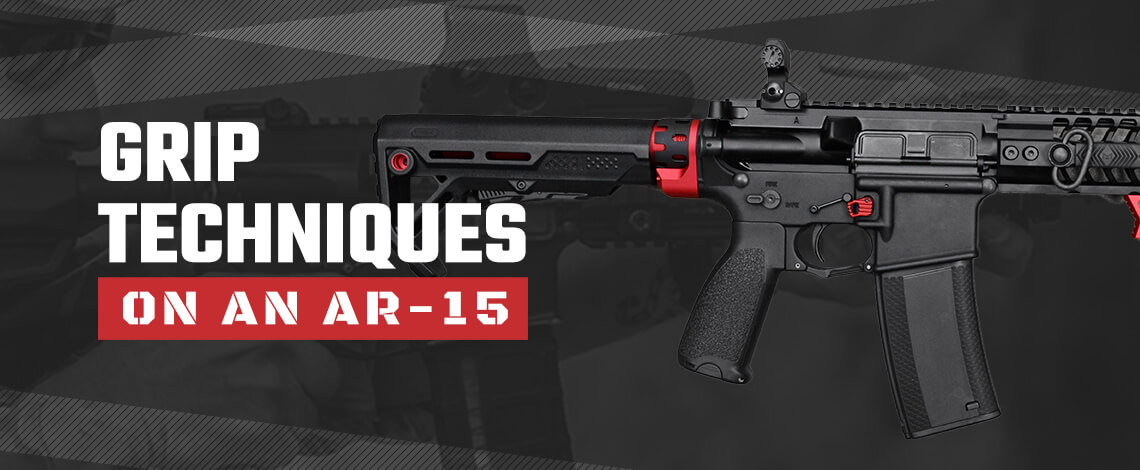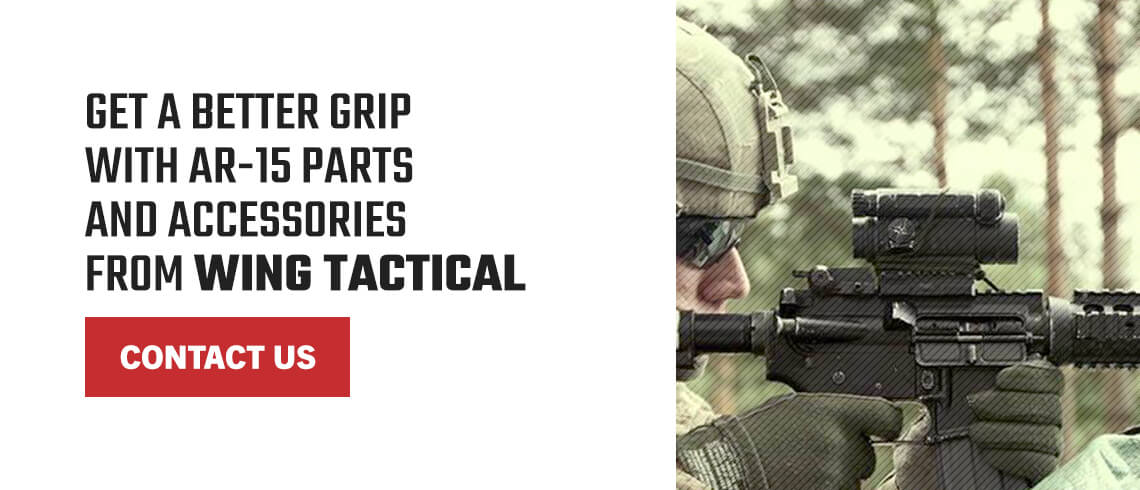
Accurate shooting with an AR-15 starts with the fundamentals. Your gear, attachments, ammunition, optics and everything else are important, but all secondary to the way you hold your weapon. A good grip is essential to control where you place your rounds, and your forward hand plays a vital role — naturally leading to the question of where to put yours. Rather than a single correct answer, choosing the right grip technique for an AR-15 comes down to finding the one that works best for you.
Basics of AR-15 Grip Technique
Grip technique can be subjective, meaning what works for one shooter may not work for another. That's why it's so important to trust your intuition. Your body has a natural awareness of your movement, posture, balance and location known as proprioception. When you let your instincts guide you, your proprioception helps you maintain good control of the muzzle without having to think too hard about it.
THE THREE PRIMARY AR-15 GRIP TECHNIQUES
Your forward hand needs to provide you with a stable shooting platform if you want to put consecutive rounds into tight groups. If you look around the range, you might see shooters using several different grip techniques to get there, including C-Clamp grips, magwell-hold grips and aftermarket foregrip attachments.
One of the main differences between these techniques is where you place your support arm and hand while firing. Some people prefer the support arm underneath the handguard with the hand relaxed, while others favor extending the support arm as far forward on the handguard as possible. But ultimately, there's no single correct grip — it's mainly a matter of preference.
While some shooters get a little passionate about one grip or another, all three work toward achieving the same goal. They are also all adaptable for right and left-handed shooters. In the correct application and with a little bit of practice, you can become proficient with any of the primary grip techniques on an AR-15.
1. C-CLAMP
The C-Clamp grip technique comes from the competitive shooting community. This popular style aims to reduce recoil and muzzle rise while keeping an unobstructed sight picture. This grip also helps you make quick transitions between targets.

To get into a C-Clamp grip, extend your support arm down the length of your handguard. Place your hand underneath the guard with your palm facing up and point your index finger toward the barrel's end, without touching the barrel. Thumb placement is a matter of preference. You can place your thump alongside your palm or wrap it around the top of your rifle. This style of grip works well both with and without a vertical or angled foregrip.
This style of grip works well both with and without a vertical or angled foregrip. However, using the C-Clamp grip in conjunction with a foregrip can help reduce muzzle jump and recoil by applying backward pressure, which keeps the stock firmly anchored against your shoulder. Keep in mind that if you use a C-Clamp grip with a foregrip, you may need to move the foregrip back slightly.
2. MAGWELL HOLD
Gripping an AR-15 by the magwell is a classic technique. Of the three, a magwell hold can be the most comfortable. This position puts your arms in close to your body, letting you rest the weight of the rifle against your torso to reduce fatigue. This position provides limited recoil management and is best for engaging targets at short range.

With this grip, your trigger hand grasps the lower receiver by the grip and your support hand clamps the magazine well. Getting into a magwell-hold grip technique is easy. Bring your support hand up underneath the junction of your handguard and upper receiver. Next, clamp your magazine well with your fingers on one side and thumb on the other. If you want added comfort and even more stability, you can install an aftermarket magwell grip attachment.
Getting into a magwell-hold grip technique is easy. Bring your support hand up underneath the junction of your handguard and upper receiver. Next, clamp your magazine well with your fingers on one side and thumb on the other. If you want added comfort and even more stability, you can install an aftermarket magwell grip attachment.
The magwell hold moves the balance point of the weapon forward toward the middle of the handguard, making it a good choice for shortened stocks and small-stature shooters.
3. AFTERMARKET FOREGRIPS
Foregrips attach to AR-15s equipped with rail handguards. These grips help you pull the gun in closer to your shoulder to absorb recoil. They also offer high mobility and excellent field of view from virtually any shooting position.

Two styles of foregrips are available:
- Vertical foregrips: A vertical AR-15 foregrip comes straight down from the handguards and is easy to pull into your body.
- Angled grips: Angled grips come in varying angles under 90 degrees, bringing your hand closer for more surface contact.
If you're using a vertical foregrip, you should position your grip as far forward as possible to keep your support arm in line with the barrel. This positioning allows for faster target acquisition and a more intuitive barrel swing.
If you're using an angled foregrip, your hand is more in line with the rifle bore, allowing for placement closer to the rail. To hold it properly, your support hand needs to wrap around the grip so you can maintain backward pressure against your shoulder.
Check out our article on how to use foregrips to learn more about gripping with vertical and angled foregrips.
AR-15 Grip Technique Tips
Every shooter has a different build and preferences, so you'll need to try a few different grip types to find the option that suits you best. The right grip for you will be the one that feels comfortable while providing consistent accuracy.
As you play around with your grip, you can make adjustments to your body posture and hand location to improve your results. For example, placing your hand higher up on the handguard usually provides better spatial awareness. You also want to avoid locking out your elbow on your support arm, as keeping the joint looser will help absorb recoil.
GET A BETTER GRIP WITH AR-15 PARTS AND ACCESSORIES FROM WING TACTICAL
At Wing Tactical, we have the parts and accessories you need to set your AR-15 up however you want. Our staff knows these rifles inside and out and can point you toward the right products to meet your needs. Contact us online today for expert assistance.
